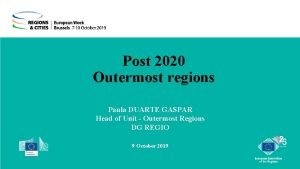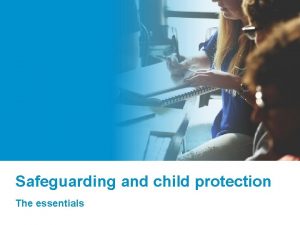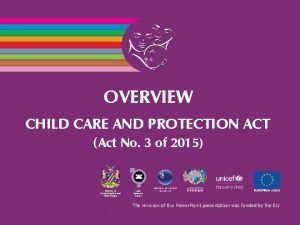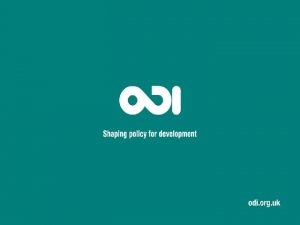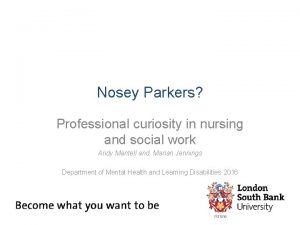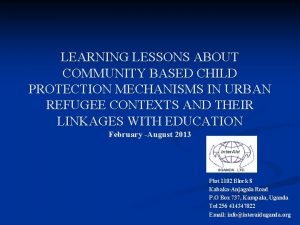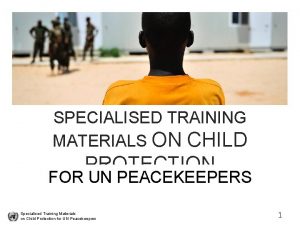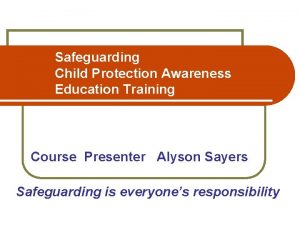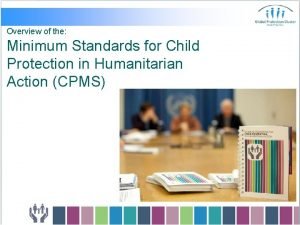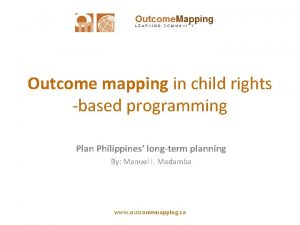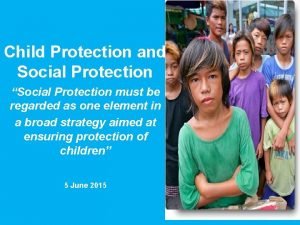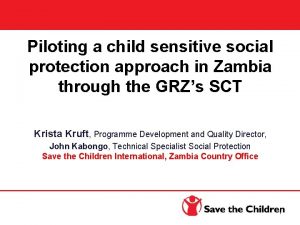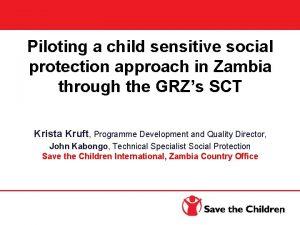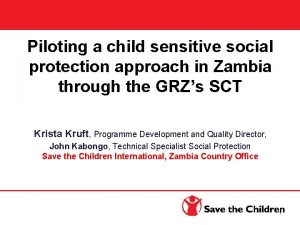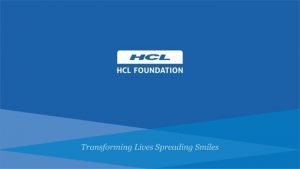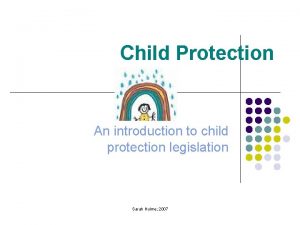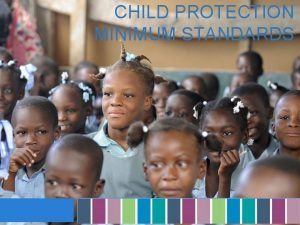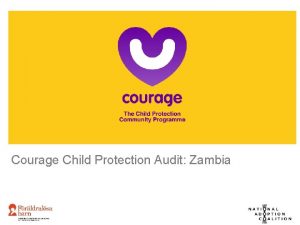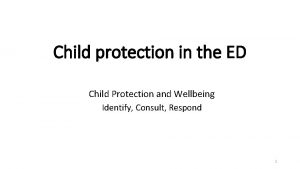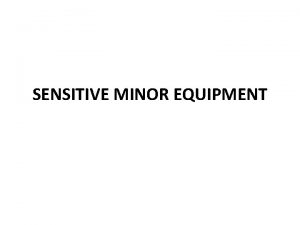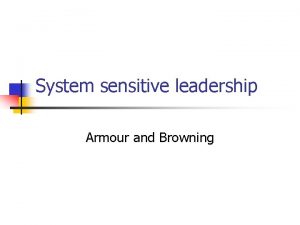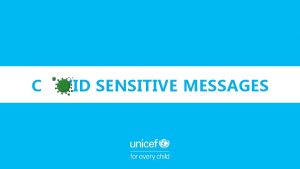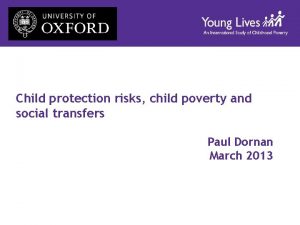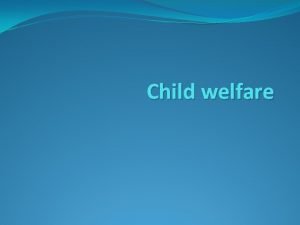Child Sensitive Social Protection Gaspar Fajth Chief Social



























- Slides: 27

Child Sensitive Social Protection Gaspar Fajth Chief, Social Policy and Economic Analysis, UNICEF Policy and Practice, New York gfajth@gmail. com Strategies for the extension of Social Protection Turin 5 October, 2009

The themes of this presentation 1. 2. 3. 4. 5. Introduction: the SPF-I and children Why Social Protection needs to be child sensitive? What is so special about children? The relevance of social protection programmes for children Challenges, issues

1. Introduction: the Social Protection Floor and children UN Crisis response (April 2009) • – – The Social Protection Floor • – – – • • • Comprehensive Framework for Action (Food Taskforce) Joint Crisis Initiatives (#6: Social Protection Floor) Basic social services Income security Focus on poor and vulnerable populations Initiative and/or approach? The issue of national ownership Joint Statement on Child Sensitive Social Protection (August 2009) The aim of this session

Poverty and absolute child deprivation: global evidence • • • Chance of a woman dying from complications during pregnancy or delivery: – Ireland: 1 : 48, 000 – Niger: 1: 7 Chance of a child dying during her/his first 5 years of life – Hungary: 1 : 143 – Cameroon: 1: 7 Risk that a child will never attend school – Developing countries: 1: 7 Risk that a young child will be malnourished – Developing countries: 1: 3 Risk that a child will live in absolute poverty (severe human deprivation) – Developing countries: 1: 2 Risk that the child will live in household with no access to social protection – World: 4: 5

2. Why Social Protection needs to be ‘child-sensitive’? Many societies want to prioritize children/make progress on the MDGs Social protection can reduce future poverty • • – through preventing risks, protecting from impact, promoting proactive responses and transforming the legal environment and/or societal values Children’s experiences of poverty and vulnerability are different from those of adults • – – – loss of family care is a significant risk for children in the contexts of malaria, HIV/AIDS, conflict, humanitarian crises, and juvenile justice and child protection practices children’s complex physical, psychological , emotional and intellectual development create particular opportunities as well as vulnerabilities they can not and should not respond alone

Child poverty has been defined as • – “Child sensitive social protection” therefore needs • – – – – • “deprivation of the material, spiritual and emotional resources needed to survive, develop and thrive, leaving [children] unable to enjoy their rights, achieve their full potential or participate as full and equal members of society” (SOWC 2005) to have a multidimensional focus look at the options of child-centered as well as adult-centered programmes to be developed as an evidence-based approach consider the fiscal and political realities, but aim at maximizing opportunities and developmental outcomes for children within given constraints challenge those constraints taking advantage of evidence on progress elsewhere develop indicators and analyses, assessments raise awareness and build a coalition for making social protection child sensitive Questions?

3. What is so special about children? • • • Moral and legal commitments High returns to investment Short window opportunity Strong gains from combination of interventions High risks that investment will not happen

Moral and legal commitments • Private and public support – Households • intra- and inter-household distribution and use of resources • coping strategies are not always sustainable/may have negative child impact – Corporate sector responsibility • business strategy • workforce (HR) policy – Public authorities • laws, policies, programmes • transparency, accountability, effectiveness and efficiency • Questions What factors influence these? How can we measure and/or influence them?

Moral and legal commitments (cont’) • 1989 Convention on the Rights of the Child – The rights of the individual child • • citizenship family health education protection from abuse access to social security maximum available resources international collaboration – Legislative reform and implementation • Questions: What are the implications? How to operationalize/prioritize/make progress?

Evidence on the high returns from investing in children • Micronutrients for children – the most productive global investment (Copenhagen Consensus, 2008) – providing essential vitamins and minerals would cost $60 million per year and hold annual benefits above $1 billion: a 1500 per cent rate of return (Horton at al 2008) • Early childhood development – analysis of four early childhood and pre-school programmes indicates benefit-cost ratios range between 3. 8 -17. 0 to one in the US (Schweinhart, L 2004) – Indonesia Early Childhood Development Project suggests a ratio of 6 to 1 (World Bank 2009) • Infant and maternal nutrition – intergenerational effects – evidence in rural Guatemala suggests that for every 100 gram increase in maternal birth weight, her infant’s birth weight increased by 29 grams (Ramakrisnan at al 1999) • Basic education – the estimated rate of return to one additional year of schooling is 10 per cent on average globally even without counting the social benefits of better education (Psacharopoulos at al. (2004) • Child protection – Children from socio-economically deprived families had a chance 700 times the average for placement in substitute care in the UK (Bebbington and Miles, 1989) • Question: How evidence like these could be used in the policy process?

Short window opportunity • Permanently damaging effects of even temporarily lack of support

Strong extra gains from combined interventions For example: • Nutrition – calorie, protein, micronutrients intake as well as water and sanitation, disease control • Stimulation – cognitive learning and emotional support • Best results come from a combination of nutrition support and stimulation for young children

Good nutrition and psychosocial development help each other In a Jamaican study, stunted children aged 9 -24 months were randomly assigned to nutrition only, stimulation only, nutrition and stimulation, and control group and IQ was monitored … The benefits from a combination of nutrition supplements and stimulation were additive: after 2 years of intervention the children receiving both treatments caught up to the nonstunted control group (top line)

But remember! Stimulation works also the other (negative) way… • Stigma and “low expectations” influence child behaviour – The case of competition at a maze in India: children's performance differed when their caste was made public! (WDR 2006 p 76) • Stress can permanently lower memory capacity in children – new research finds causality between chronic stress associated with poverty and impaired brain development in children (Economist 04. 09) • These findings are particularly important – in the context of gender, adolescent, HIV/AIDS-related, poverty alleviation and special needs (child disability) programmmes – when making decisions on targeting of social programmes

High risk that child-related commitments will not be realized/investment will not happen • Structural poverty and/or social exclusion – – – poor maternal nutrition, health loss of parental upbringing low parental education and/or parenting skills low awareness on children’s needs and/or opportunities discrimination (e. g. gender, disability, ethnicity) poor access to assets and income • Current poverty impacts – Idiosyncratic shocks (catastrophic health expenses, loss of a family member, loss of jobs etc) – Aggregate /covariate shocks (economic, social or environmental crises) • Agency and governance issues – Voicelessness – Principal agent issue/relational nature of child well being (dependency on adults)

Summary: children should get priority in public policy Moral and legal commitments – Private and public support – 1989 Convention on the Rights of the Child High returns to investment – Childhood is the best opportunity to invest in human resources – Broader social and economic gains; returns tend to be particularly high among girls Short window opportunity – Permanently damaging effects of even temporarily lack of support Strong positive feedback from combination of interventions – Progress needed at all major dimensions of child well being High risks that investment will not happen, due to – – – Structural poverty and/or social exclusion Current poverty impacts due to economic, social or environmental crises Governance and agency issues Strong evidence on the impact of poverty on children

4. The relevance of social protection programmes for children • • • Social protection is part of broader development policy Social protection cuts across many sectors The principles of Child Sensitive Social Protection Social protection programmes relevant for children Are Conditional Cash Transfers magic bullets? How programmes could address the continuity of risk and vulnerability

Social protection is part of broader development policy Source: World Bank 2008

Social protection cuts across many sectors Nutrition Social Policy Health Water and sanitation Child protection Education Social Protection Social welfare Source: UNICEF

• • • Transfers could help removing barriers on the demand side However, action on the supply side of services is often also necessary Income/consumption poverty is a major barrier But poverty is multidimensional and factors other than income matter too! The structure of social expenditures shows different patterns by regions: Source: World Bank 2008

Social protection programmes relevant for children • Social assistance (safety net) programmes – Targeted child grants (unconditional) – Conditional cash transfers (CCTs) – School feeding and other nutrition programmes – Fee waivers (health, education) and other in-kind transfers – Emergency programmes (cash handouts, social funds, nutrition, education kits etc. ) – Workfare programmes, active labour market policies (including youth programmes) – Means-tested unemployment benefit or other social assistance – Social pensions • Social insurance programmes (contributory) – Cash family allowances (often hidden as tax benefits) – Maternal and parental benefits – Sick leaves – Public health insurance – Unemployment benefit – Public pension schemes

• Universal social protection programmes – Birth grants (conditional to birth registration) – Pre-school programmes (subsidized) – Social care services (visiting nurses, counseling, shelter, respite care services etc. ) – Free health services (e. g. on maternal and child health) – (Public health measures and free education is not considered as social protection, but these are very important for children) – Universal child grants/allowances – Price subsidies (staple and other food, fuel and energy, housing, water etc. ) • Social protection is also private…

Conditional Cash Transfers – a magic bullet? • What is a CCT? – Social assistance programmes that provide cash transfers on evidence that households use health, education or other services (e. g. social work services in Chile’s Solidario) – Focus on addressing structural poverty through investment in children’s human capital – Conditionalities - e. g. compliance with immunization plans, checkups for pregnant women, regular school attendance, participation in parents-teachers meetings etc. • Key examples – The Bolsa Familia in Brazil and the Oportunidades in Mexico, which cover respectively about 12 and 5 million families with a budget less than 0. 5 % of GDP • Key features – The practice of evaluation – demonstrating results, helping political acceptance and improving design – High concentration on the poor – the share of beneficiaries in poorest income quintile fall between 32% (Education Support Project in Cambodia) and 74% (Bolsa Familia) – Programme non-compliance could reach up a third or more of targeted beneficiaries – Administrative costs hover between 4 and 20% – Gender considerations

How programmes could be integrated to address the continuity of risk and vulnerability Examples: • “A” type interventions: countercyclical macroeconomic policy, free basic education, immunization • “B” type interventions: child/family allowances, preventative social work services • “C” type interventions: intensive/emergency social work services • “A - B” types together: Bolsa Familia CCT (Brazil) • “B - C” types together: Solidario CCT(Chile)

Principles of child sensitive social protection 1. Avoid adverse impacts on children, and reduce or mitigate social and economic risks that directly affect children’s lives 2. Intervene as early as possible where children are at risk, in order to prevent irreversible impairment or harm to children 3. Consider the age and gender specific risks and vulnerabilities of children throughout the lifecycle 4. Mitigate the effects of shocks, exclusion and poverty on families, recognizing that families raising children need support to ensure equal opportunity 5. Make special provision to reach children who are particularly vulnerable and excluded, including children without parental care, and who are marginalized within their families or communities due to their gender, disability, ethnicity, HIV/AIDS or other factors 6. Consider the mechanisms and intra-household dynamics that may affect how children are reached, with particular attention paid to the balance of power between men and women within the household and broader community 7. Include the voices and opinions of children, their caregivers and youth in the understanding and design of social protection systems and programmes.

5. Challenges, issues • Low and unequal access to SP • Focus on structural versus transient poverty • Affordability (% of GDP, % of public spending) • Political support and public attitudes • The issue of targeting (means-tested, categorical) • The issue of conditionality • Trade-offs (within SP and over education or other public programmes) • Negligible positive or negative effects (work and fertility effects, crowding out, stigma, worse child outcome etc. ) • Gaps in attention to social are services and women in the labour force • The culture of evaluation (missing, narrow) • Administrative feasibility (corruption, capacity, costs, transparency) • Local ownership and exportability of key SP tools (local context) • Low awareness and/or low priority

Thank you!
 Chapter 9 lesson 3 commander in chief and chief diplomat
Chapter 9 lesson 3 commander in chief and chief diplomat Paula duarte gaspar
Paula duarte gaspar Varju nemzetseg hangoskonyv
Varju nemzetseg hangoskonyv Gaspar olmedo
Gaspar olmedo Cinbalos
Cinbalos Kombinirani strujni krug
Kombinirani strujni krug Gáspár merse előd
Gáspár merse előd Auto pastoril del nacimiento gil vicente
Auto pastoril del nacimiento gil vicente Croli
Croli Edificio gaspar de rodas
Edificio gaspar de rodas Safeguarding and child protection the essentials
Safeguarding and child protection the essentials Courage child protection
Courage child protection Types of child protection
Types of child protection Children's responsibilities
Children's responsibilities Child marriage definition
Child marriage definition Child protection case management tools
Child protection case management tools Types of child protection
Types of child protection Child protection and toy safety act
Child protection and toy safety act Professional curiosity in social work
Professional curiosity in social work Community based child protection mechanisms
Community based child protection mechanisms Child care and protection act 3 of 2015
Child care and protection act 3 of 2015 Child protection training materials
Child protection training materials Child protection awareness training
Child protection awareness training Child protection minimum standards
Child protection minimum standards Child protection policy
Child protection policy 2 disinterested person
2 disinterested person Child protection reform amendment act 2017
Child protection reform amendment act 2017 전위 순회
전위 순회

